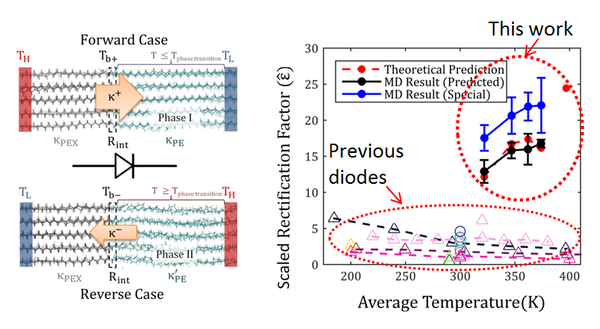
The unparalleled development of information technologies originates from the inventions of several critical electronic devices which can manipulate electron flow, exemplified by the solid-state electronic diode. While electronics dominate today’s information technologies, their counterparts – phononics, which also have the potential to transmit and process signals, have not yet been realized in applications. Instead of controlling electron flow, phononic devices control thermal energy (heat) flow, which is much more abundant than electrical energy. Over 90% of the world energy production is related to heat flow with only around 13% converted into useful electricity and even less used for electronics. Due to the abundance of thermal energy, the realization of phononics may result in even more wealthy applications than electronics. A new study from Prof. Luo's group has identified a high performance thermal diode based on polymer fibers, which may ultimately lead to the realization of phononic computers.
Thermal rectification is the key for heat flow control, and a device that rectifies heat flow is called a thermal diode. Thermal diode allows larger heat flux in the forward direction than that in the reverse direction given the same temperature difference (see figure blow). To quantify the performance of a thermal diode, the dimensionless temperature-scaled rectification factor, ε, is usually used. Previously reported thermal diodes have ε < 8. This limitation largely prevents the practical applications of thermal diodes.
In a recent paper published on Small (http://onlinelibrary.wiley.com/doi/10.1002/smll.201501127/full), highlighted as a Frontispiece in issue 36 of 2015, Teng Zhang and Tengfei Luo proposed a thermal diode with unprecedented rectification factor. The diode is made of polymer nanofibers and achieves high rectification factors by leveraging the phase transition-enabled large thermal conductivity change. The proposed polymeric thermal diode not only achieves large rectification factor, but also only needs a very small temperature bias (< 20 oC) – previous didoes need hundreds of degrees for operation.
Based on the thermal conductivity switching effect in polyethylene (PE) nanofiber (Zhang and Luo, ACS Nano, 7, 7592 (2013)), the proposed thermal diode consists of a crystalline PE nanofiber connected to a cross-linked polyethylene nanofiber (PEX) end-to-end (see figure below). The crystalline portion has a phase dependent thermal conductivity, while that of the PEX portion is not temperature-sensitive. A 20 K temperature difference is then applied across the PE/PEX junction to impose heat flux, and the direction of heat flux changes by flipping the temperature bias. When the crystalline end directly contacts the heat source, the crystalline portion switches to a low thermal conductivity phase and the junction expresses an overall low heat flow state. When the crystalline end is exposed to the heat sink, the crystalline portion switches into a high thermal conductivity phase and the junction shows an overall high heat flow state. By flipping the temperature bias, such polymeric thermal diodes are found to yield a temperature-scaled rectification factor as high as 25 (see figure below), which are giant compared to those of the previously reported thermal diodes (< 8).

This theoretical research may open up a new direction for thermal rectification research and provide important guidance to achieve practically usable thermal diodes based on inexpensive and easily processible polymer fibers, based on which thermal circuits can be built to ultimately enable phononic computing. Besides phononic computing, thermal diodes also have applications in sensors, energy storage and generation, and electronics thermal management.
This research was funded by American Chemical Society Petroleum Research Fund, Notre Dame Center for Research Computing, and NSF through XSEDE resources.